Although 3d Street Art has been around for centuries, brands have been using it for the last thirty years to sell stuff. Here's a guide to everything you might possibly want to know about 3d street art and how to use it to engage with consumers successfully.
Everything you need to know about 3d Street Art (or 3d pavement art) in Advertising or Marketing Campaigns in 2026
Have you heard of 3D Street Art? Did you know global brands have been using 3D Pavement art to draw attention to their products and services and they have used 3d Street Artists to help them create experiential marketing events and interact with millions of consumers?
In this article, we tell you what 3d Street Art is and how you can include it in your marketing mix. Our guide to 3d Street Art tells you everything you need to know including:
What is 3d Street Art
The History of 3d Street Art
How to use 3d Street Art
Which brands have worked with 3d Street Art
3d Street Art legality
The 3d Street Art process
How to maximize the return on investment of a 3d Street Art advertising campaign
How to measure a 3d Street Art campaign
3d Street Art- the artwork
The best locations for 3d Street Art
3d Street Art examples
3d Street Art Campaign case studies
How much does a 3d Street Art campaign cost?
How to start your 3d Street Art campaign
Everything you need to know about 3d Street Art or 3d Pavement Art
The Step by Step guide to creating a 3d Street Art advertising campaign
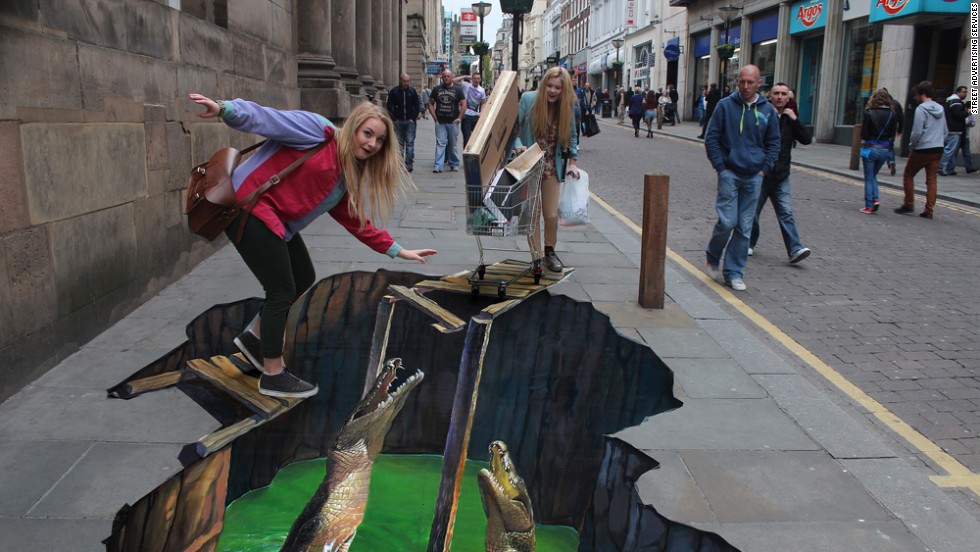
1. What is 3d Street Art?
3d Street Art (also known as 3d pavement art or 3d sidewalk art) is a type of artwork painted or drawn in a specific way that creates an optical illusion that tricks the mind into believing that the 2d artwork they are reviewing is three-dimensional. Often viewed from one point of perspective the skill of the 3d street artist creates an illusion of depth or height in their picture and the 3d street art looks very skewed or slanted when viewed from the wrong angle. Typical examples of 3d Street Art illusions include looking down into a large crevasse or making a person look like they are standing on top of a large object. The reason why 3d street art is so popular is not only is it visually spectacular but it’s also fun and interactive.
Most 3d Street Art can only be properly seen through a camera or phone camera so even though a person can visualize what the artwork is supposed to look like with the naked eye it’s only when they see the picture through their phone that it pops into 3d! We call this the Wow moment! And it’s like a magic moment when all the perspective and lines and shading meet together to create a magic moment and it’s this moment that makes 3d street art so fun and engaging as a person remembers this feeling for a long time after.
This feeling creates a huge talking point. This makes it perfect for using it in experiential marketing as the artwork creates a natural point of attraction for a brand conversation in addition the 3d pavement art is a brilliant prop for a great selfie which then gets shared online through social media and traditional media.
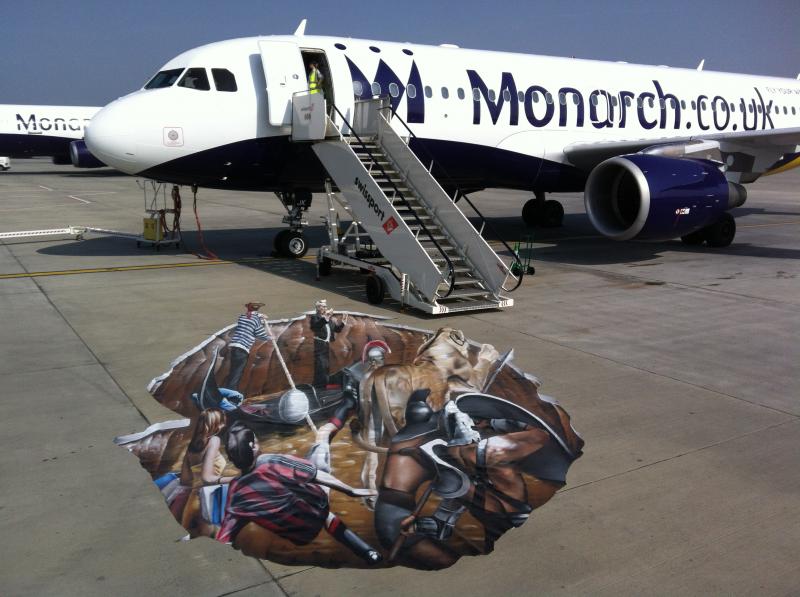
Here is an example of 3d Street Art created for Monarch Airlines
3d Street Art is also known by other names such as: 3d Art, 3d Pavement art, 3d sidewalk art, 3d chalk art, Trompe-l’œil, street painting or anamorphic art.
2. The History of 3d Street Art
The painting of forced perspectives can be dated back to Ancient Greece. Zeuxis (born around 464 BC) is often referred to in a tale of two rival painters tricking each other with optical illusion paintings. Anamorphic art began gaining popularity in the Renaissance period when Italian painters of the late Quattrocento such as Andrea Mantegna (1431–1506) and Melozzo da Forlì (1438–1494), began painting illusionistic ceiling paintings, generally in fresco, that employed perspective and techniques such as foreshortening to create the impression of greater space for the viewer below. Trompe-l’oeil (trick of the eye) Trompe-l’œil, in the form of “forced perspective”, has long been used in theatre set design, to create the illusion of a much deeper space than the actual stage. An often quoted early example is the Teatro Olimpico in Vicenza, with Vincenzo Scamozzi’s seven forced-perspective “streets” (1585), which appear to recede into the distance.
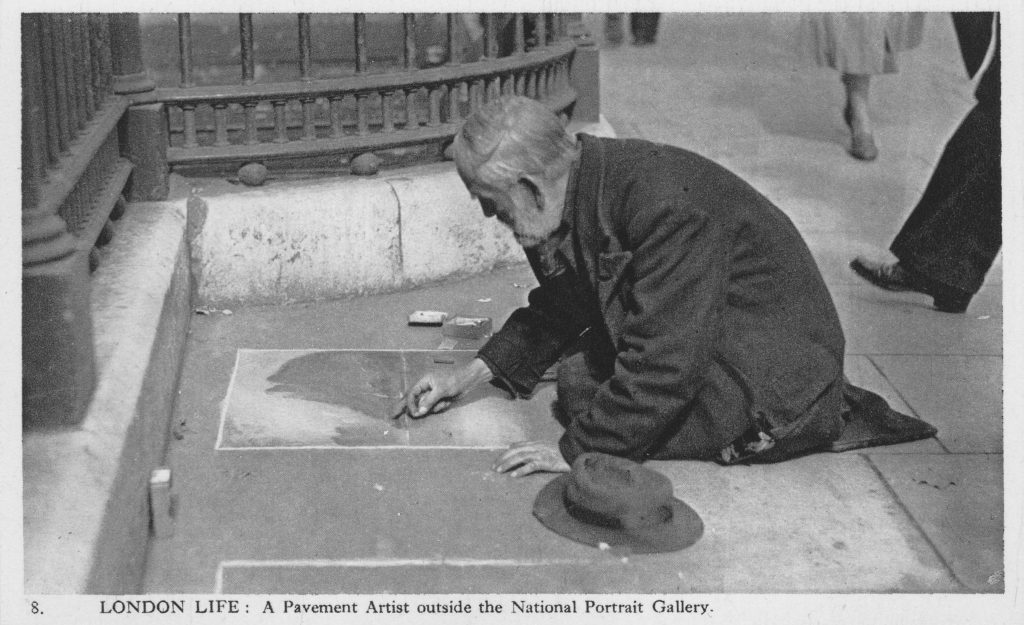
The history of modern street art painting can be traced to Great Britain. Pavement chalk artists were spotted all over the United Kingdom and by 1890 it was estimated that over 500 artists were working as pavement artists in London.
The traditional English word for a street artist is “Screever”. The term comes from the writing style, usually called Copperplate, that pavement artists used since the 18th Century. The word Screever has been cited as a Shakespearean slang which dates back to the 16th Century.
The paintings or drawings of screevers were usually created along with a poem or citation or proverb and were reflections on morality or current affairs. Screevers’ work was often appreciated by all classes of society and appealed to both the working class who couldn’t read with their fine artistry and the moral reflections also caught the eye of the upper classes who could afford to throw a penny into the hat of the struggling artists.
Street painters also appeared all over Europe and the United States and went by names such as Maddonari in Italy (as they often painted Madonna) and Strassenmaler (Street Painter in Germany)
More recently, in the 1980s Kurt Wenner introduced 3-D pavement art. Wenner was an ex-NASA engineer who used a combination of his knowledge of mathematics and fine art to create spectacular artwork in a 3d illusion that was then printed onto a canvas or vinyl and installed on the street.
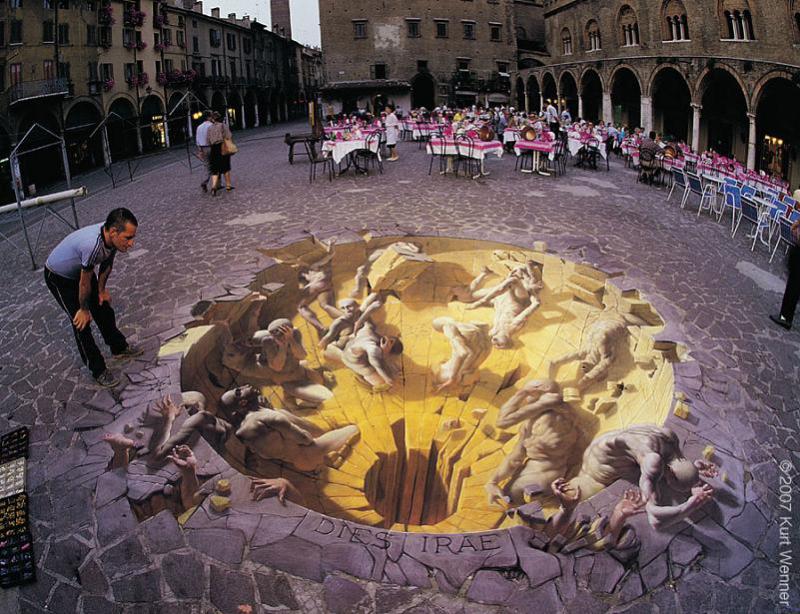
For further information please refer to Wikipedia’s History of Street Painting article
3. How to make a 3d painting
Our brains follow a set of guiding principles when they interpret the signals our eyes send. So objects that are further away seem smaller and objects closer to us are larger. 3d Street artists play tricks on our brains by painting objects that are further away as larger in the distance and smaller close up. When this effect is combined with forced perspective and a distant horizon our brains get scrambled! For example, our brain understands that an object in the distance is not only smaller but more blurred with lighter shading and definition, likewise an object close by is sharply defined. If an artist uses less definition and lighter coloring for the front of the picture but heavier lines and coloring in the area further away from the viewer they create an illusion of height.
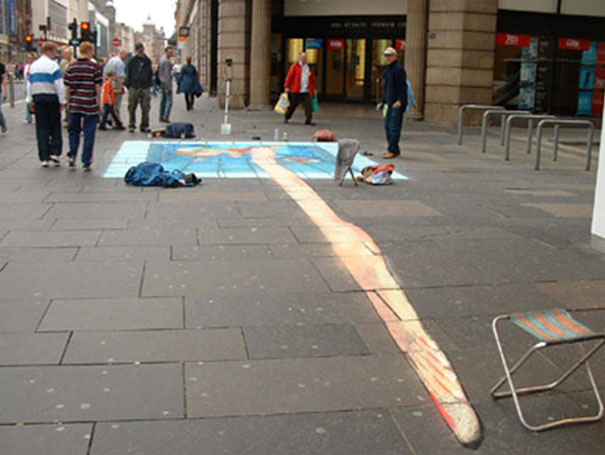
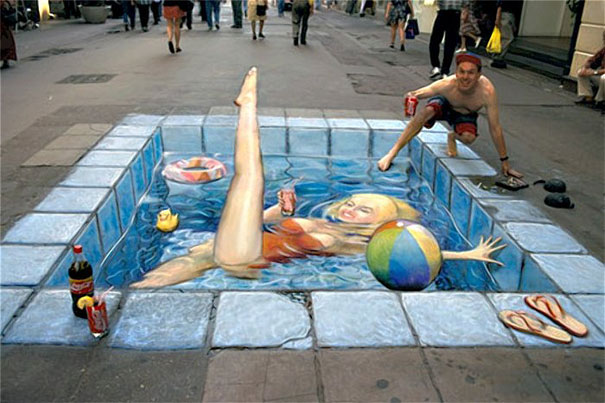
3d Street Art is a combination of science and fine art. Painters will sometimes use a Grid to stretch the image of the objects they want to paint to create the stretched look essential to achieve the illusion. Alternative methods include using a projector pointed from the height and distance of the viewer then the outline of the spilled light image is traced onto the camera to recreate the picture on the ground.
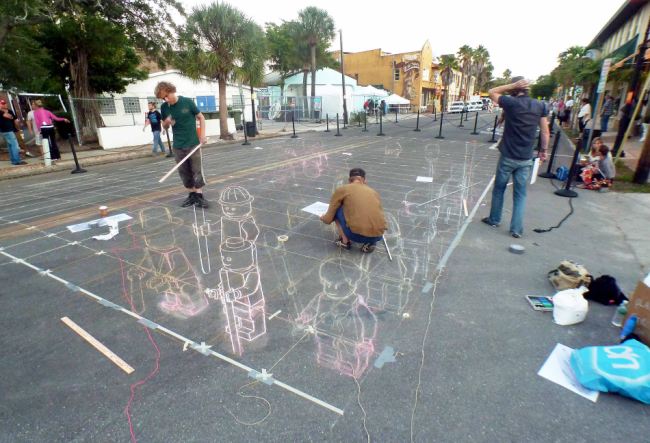
For a step-by-step guide to 3d painting techniques check out the following articles:
3d Street Art: a question of perspective
Secrets Behind how 3d Street Art is made
4. How are brands using 3d Street Art?
3d Street Art is now predominantly used by brands and businesses to bring attention to their products and services as a way of either engaging with consumers in an experiential campaign or by using the artwork to create online content to share their brand message.
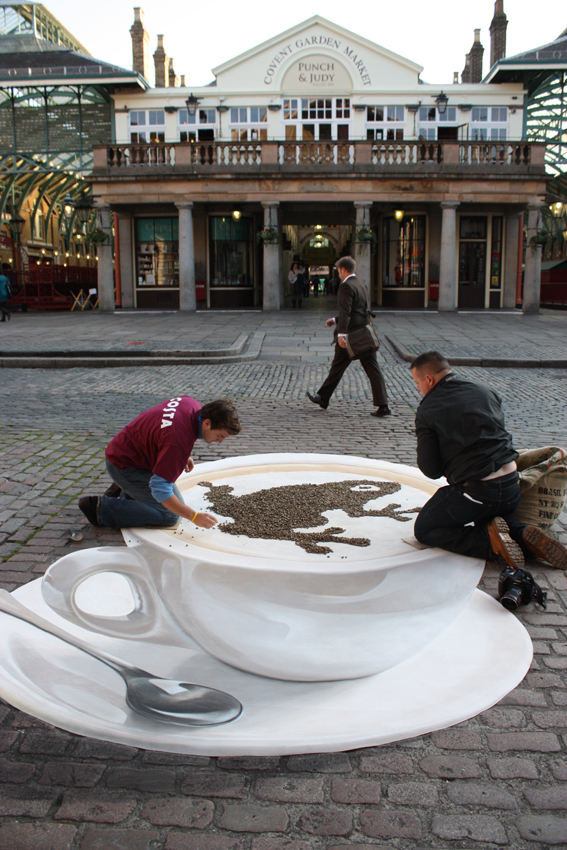
The benefits of using 3d Street Art in a campaign are:
Engages consumers in a natural, friendly, and fun way
Consumers then go on to share their experience by either taking their photo or a photo taken by the brand and shared online. Photos of this nature with an unusual backdrop and fun interaction are then shared and engaged with by more people and subtle branding in the photo and artwork ensures earned media
The use of a hashtag when sharing photos through social media allows for tracking online
Traditional media uptake and P.R.E (PR Value equivalent) are typically good as 3d street art provides good visual content for newspapers TV and online media.
Brand Sentiment- Consumers feel good about brands that use 3d artwork to engage with them. It’s an easy and natural way to start a conversation with brand ambassadors accompanying the 3d pictures.
Brands that use 3d Street Art in their marketing mix, usually have one of the following objectives for their campaigns:
Launch of a new Product or service
Increase Brand Awareness
Increase or Initiate Sales
Highlight a future event
Signpost to a retail location or event
A sampling of a product
Education of a public service message
Awareness of a charity- charity fundraising
5. Which brands have worked with 3d Street Art?
Hundreds of brands have used 3d Street Art in their brand campaigns. Here is a list of brands who worked with Street Advertising Services to create their 3d street art campaigns:
Microsoft, Intel, British Heart Foundation, SciFy Channel, Marshalls, Anglian Water, Visa, American Express, Seaworld, ING, Glaxo, Peugeot, Shell, Hyundai, Alpari, Travelodge, Monarch Airlines, Muller Yoghurts, Roche, British Heart Foundation, Water Aid, Red Cross, Autotrader, Liverpool FC, Ebbokers, Rockwool, Unilever, Ikea, First Circle, The Conservative Party, The Money Shop, Nectar Card, Honda, DK Publishing and Lucasfilm, Loch Fyne, Jaguar Land Rover and many many more.
Other brands that have used 3d Street Art in their marketing campaigns include Reebok, Cadillac, Costa Coffee, Lego,
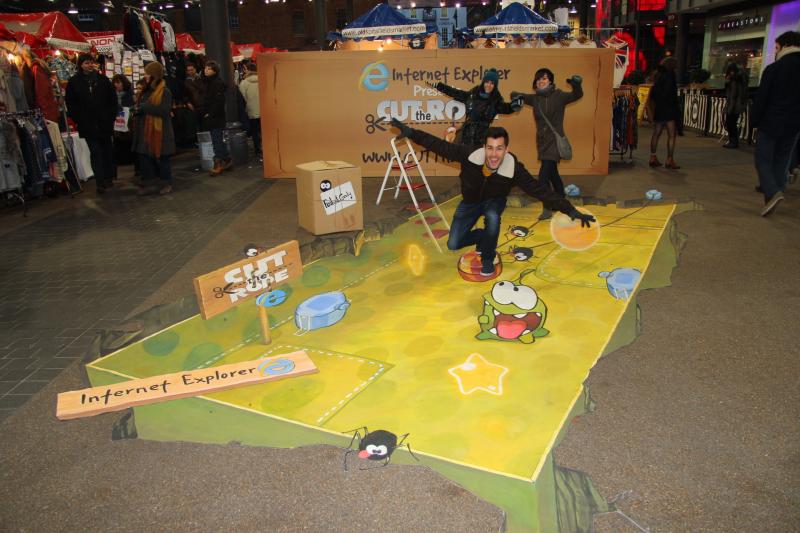
6. Is 3d Street Art Legal?
100% Legal. Although Street Art sounds edgy and feels like graffiti, when used for events or marketing correctly it’s perfectly legal. 3d Pavement Art is painted onto vinyl or canvas in our studios and then the artwork is taken to an event location (usually hired) and installed at the event. Typical event spaces will be busy footfall locations such as shopping malls and train stations and experiential event spaces can be hired directly. If a client chooses to take the artwork on a tour of a city or use it in a public space it is advisable to speak to the local authority or Business Improvement District to see if any restrictions are in place. But providing, no flyers are given out or any products actively sold using 3d street art in a public location is similar to laying down a picnic blanket. If you are causing an obstruction then you may be asked to move.
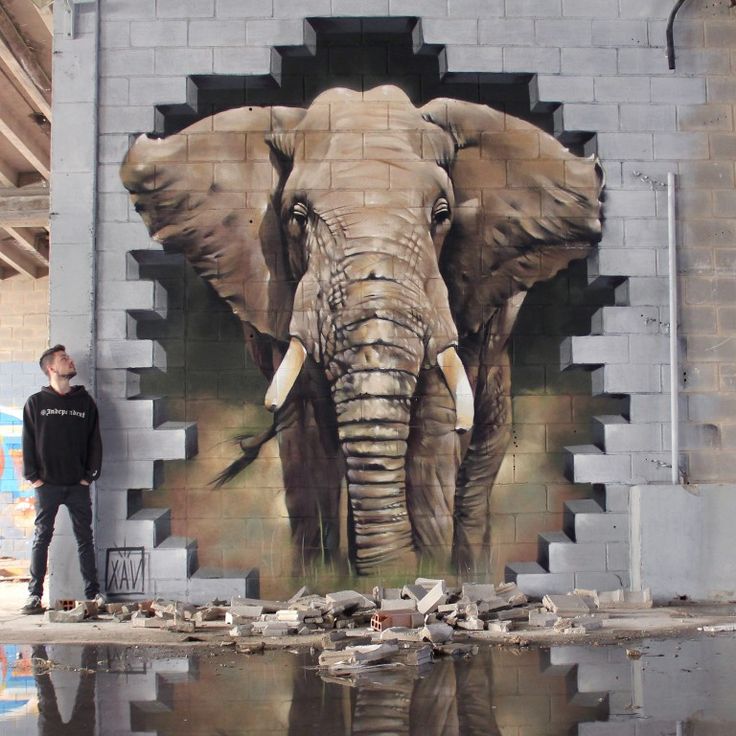
6. The 3d Street Art Process
A 3d Street Art Campaign usually starts with a client brief. Street Advertising Services will aim to get a full understanding of your campaign objectives and ensure we have clarification of any brand guidelines, colors, hashtags, and visuals that you want to include in your campaign. We will also advise you on the best way of engaging with your target audience and ensuring the artwork creates maximum engagement across all mediums. Once a 50% deposit is taken we then start the design process. We will normally create 3-4 hand-drawn concept sketches.
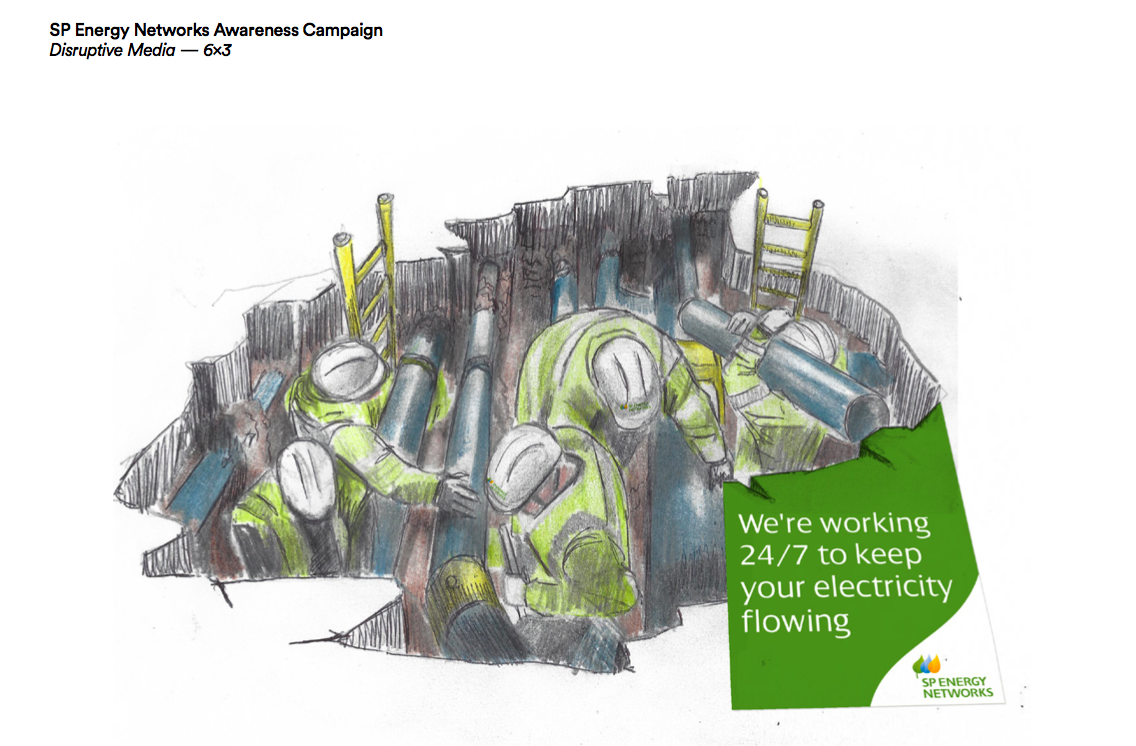
The client chooses one of these concepts and asks for any amendments or alterations at this point which we add to the sketch. The sketch is then approved and we start to paint. Once the painting is completed we then either deliver the picture to you along with instructions on how to install the artwork or we attend the event with it and work alongside your brand ambassadors to ensure maximum engagement and interaction. Usually, a client will want a combination of shared consumer interaction along with maximum online exposure to the artwork. all campaigns are created bespoke to your needs. For example, you may want consumers to take and share their photos for maximum online exposure. Alternatively, you may want us to take high-quality photos that are then shared live with consumers thus capturing their data for re-marketing to later. Either way, we can help. For a full breakdown of our services, get in touch to discuss your campaign.
7. How to maximize the return on investment of a 3d Street Art campaign
As with all marketing campaigns, the effectiveness of your ads depends on multiple factors and 3d Street Art Advertising is no different from traditional advertising when it comes to ensuring maximum return through the application of several considerations.
Right Audience- The more you know about your customer the more effective your campaign will be. In this case, think hard about where your prospective customer will dwell. Are they commuters on their way to work or young people watching the latest blockbuster at the cinema? Once you have defined the audience avatar and possible locations you need to think about the mechanics of the campaign. Do you want consumers to share their photos or do you want us to take photos and share them with consumers thus capturing their data for re-marketing?
Right Message- The most effective 3d street art marketing and advertising campaigns have been with a really fun and engaging piece of artwork that people grasp immediately. We normally advise branding and content to be subtle but essential. The right mix EG 90% entertainment and 10% education is the most effective. Making the 3d artwork fun to engage with that consumers want to have their photos taken with and shared online is a much better investment than a boring corporate logo in 3d that everyone ignores and walks past.
Right Mechanic- What is it you are looking to achieve with your campaign? Most of our clients have multiple objectives but are you diluting the likelihood of achieving your main aim by shotgunning rather than sniping? Prioritize your objectives, if getting press coverage is your chief goal then let’s create the most spectacular picture with some subtle branding and install the artwork somewhere central that is easy for journalists to access with a stunning iconic backdrop that will increase the chances of being picked up by media outlets. Likewise, if sampling is the main objective then let us make sure we pick the location of your event carefully and create a picture that guarantees a huge wow! and stops consumers in their tracks so you can engage with them with products in hand.
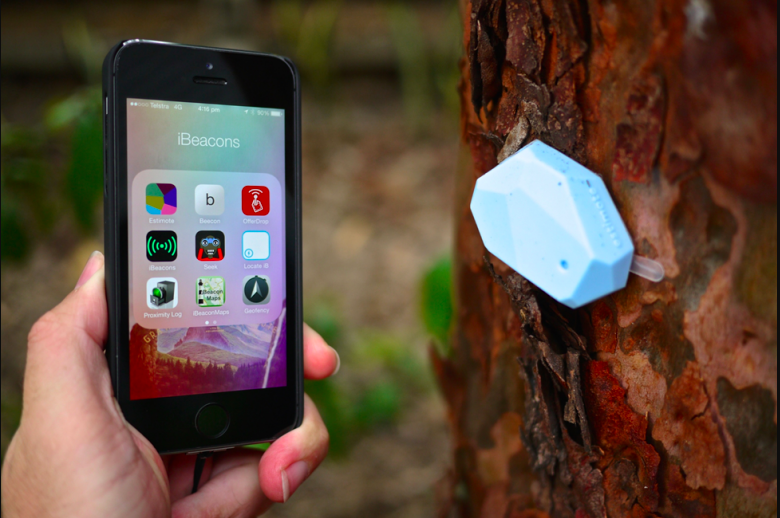
8. How to measure the effectiveness of a 3d Street Art Campaign
Your first question should be, “What do we want to measure?” Are it units sold? PR Value Equivalent? Number of likes, shares, or clicks to a website? Number of consumers interacting with the artwork or photos taken? Or even the number of leads produced? Whatever the target and measurement is, we need to make sure there is a way of tracking it. We work closely with you to ensure there is a mechanic or tool in place to track the results of the campaign. It could be a simple tool like an online hashtag tracker for measuring reach on social media or even an old-fashioned click counter to measure how many consumers spoken with. If you want to go high tech we can talk to you about using high-tech tools like racial recognition trackers to measure dwell times and sentiment. Measuring the effectiveness of a marketing campaign requires a tool to measure the response rate.
9. 3d Street Art- the artwork
The minimum recommended size of 3d street art is 6m long by 3m wide. Most 3d artwork is long and narrow, that’s one of the ways the illusion of depth or height is created. 3d Street Art is normally created on the floor but you can also create 3d painting on walls or for the best effect paint on walls and floors combined. Street Advertising Services 3d street artists can build a temporary wall structure on-site for you at your event. Pictures of any size can be created as long as they are twice as long as they are wide we have painted pictures 100 square meters in size!
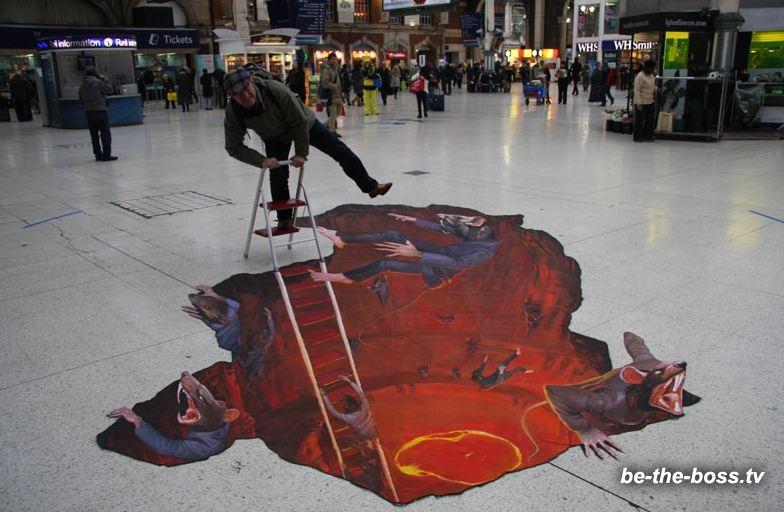
10. The best locations for 3d Street Art and How long does 3d pavement art last for?
Visa 3d art from Street Advertising Services on Vimeo.
The best place to show 3d Street Art is where people spend the most time. Obvious locations such as shopping Malls, Train Stations, Taxi Ranks, Shops, Bars, Restaurants, Fast Food Outlets, Cinemas, Theme parks, etc are all obvious locations. Commuter walk routes are also good locations so to and from public transport stations. The original artwork we paint is normally good for several uses with people standing and walking on it but if you want the artwork to be used at a retail location or where there is a lot of footfall and the artwork is to be left in situ then we would advise using a dedicated retail floor vinyl. We take your original artwork and scan it, and then the digital file can be replicated and printed onto self-adhesive floor vinyls. In rare situations, we can also paint the artwork directly onto the surface if the artwork is permanent.
11. 3d Street Art Examples:
St Mary’s School Kingswinford from Street Advertising Services on Vimeo.
Seaworld 3D Street Advertising from Street Advertising Services on Vimeo.
Quit With Help - Dublin from Street Advertising Services on Vimeo.
12. 3d Street Art Case Study
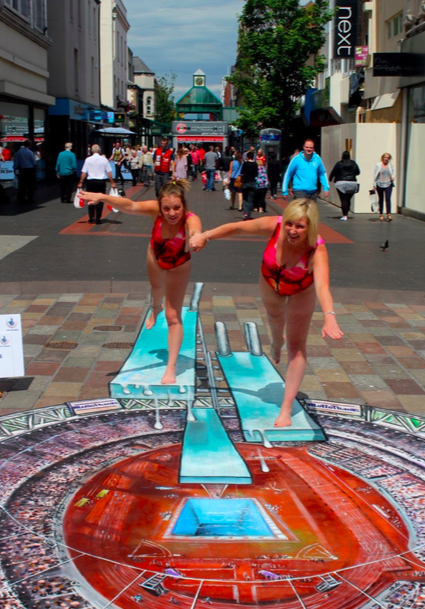
Insight
Camelot’s Good Cause team works closely with Wire Media PR Agency to generate publicity for The National Lottery’s contribution to good causes, charities, and sports funding. 2014 is the 20th anniversary of sports funding from the National Lottery and the Good Causes Team wanted to create a big splash to raise awareness of the success of British sportspeople as a result of the funding.
Wire Media and Camelot decided to highlight the funding work through the use of bespoke 3d pavement art that can create an interesting photo opportunity for Team GB athletes to pose with and that can also be used as an attraction by the public to create engagement and online sharing.
Wire Media put together a tender document and contacted several 3d street artists in the U.K and asked the companies to demonstrate their capability to deliver a highly effective campaign that could be used around the UK to deliver experiential marketing interest, online engagement and encourage free media coverage. After successfully demonstrating their experience, talent, and enthusiasm for delivering effective and exciting brand experiences with 3d pavement art, Street Advertising Services was chosen to help Wire PR create the artwork and deliver the campaign.
Strategy
Camelot and Wire Media had three prime objectives to meet to judge the campaign as successful:
Free Media Coverage of each event to deliver the brand’s campaign key messages
Create positive brand sentiment and increase awareness of The National Lottery’s contribution to sports funding within the UK through experiential marketing activity.
Online Social Media engagement with, shares, likes, tweets, views, and reach being measured.
Execution
After being provided with a detailed brief, the Street Advertising Services team of street artists began creating sketches of possible 3d street art pictures that would be interactive, entertaining, engaging, and exciting. They needed to create a 3d picture
that could be posed by any athlete and or member of the public that conveyed the general sports theme but wasn’t too specific to one type of sport.
After many sketches and design meetings, the picture was ready to paint.
To ensure the artwork would be seen throughout the UK, the artwork was painted on a waterproof vinyl that could stand up to high footfall.
Wire Media wanted the 3d artwork to be seen across the U.K so arranged a series
of 1-day events across the U.K. that were in high footfall locations and also arranged for a local athlete to pose with the artwork to create a local news element. Experiential activity was encouraged by the chance to win a free iPad at each event. Any member of the public had the chance to win an iPad by uploading a photo of themselves to their own social media accounts and the activity was linked and tracked by using #lottothanks across all accounts.
Members of the press photographers and broadcasters were invited by Wire Media to attend the event to capture the photo opportunity and interview the athlete or athletes in attendance.
Results
The 3d street art campaign exceeded expectations for all three objectives:
1. Free Media coverage:
The campaign was featured in the local press and some national press at all of the visited locations and in addition it was also featured in BBC and ITV news along with
local radio. The total number of articles and interviews was sixteen across thirteen publications on and offline throughout four locations.
The estimated Advertising Value Equivalency is estimated at £100k+
Over five hundred members of the public had their photograph taken at the events and thousands of people viewed the artwork over the four days. A lot of the photos were also taken and uploaded onto the National Lottery’s social media pages.
Social Media engagement was very high for the campaign, and photos, tweets, and comments were made across all forms of social media including Twitter, Facebook, Instagram, and Youtube…
Total reach is estimated at 6 million impressions over 30 days with over 1.2 million accounts reached and circa 500 Retweets, tweets, or uploads.
13. 3d Street Artist Names
There are about half a dozen excellent 3d street artists across the world, further examples of their work can be found on their websites:
Kurt Wenner a USA-based artist, Wenner was one of the original Modern-day Pavement artists who introduced 3d pavement art to the world in the 1980’s
Julian Beever is A Humorous English 3d Pavement artist who was responsible for creating amazing artwork that went viral on the web in the 90s. Particularly brilliant at combining street architecture with his chalk drawings.
Edgar Mueller- Austrian creator of some huge and famous 3d street art pictures of fantasy crevasses and streets of lava and ice
Manfred Staader - Netherlands Based Artist, with a great style and accessible style
13. How much does a 3d Street Art Campaign Cost?
3d Street Art starts at £6,995 plus VAT for a floor picture 6m X 3m painted onto a reusable vinyl. The cost also includes delivery and a time-lapse film of the artwork creation.
14. How to start your 3d Street Art Campaign
To start your 3d Street Art Campaign, contact Street Advertising Services today to discuss your requirements.
